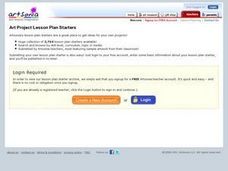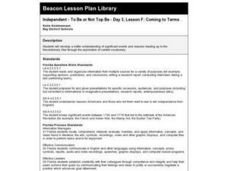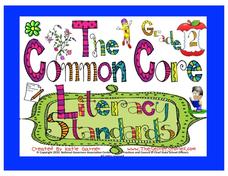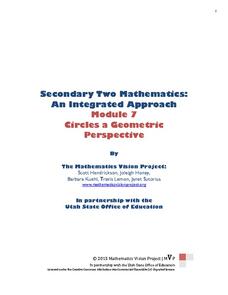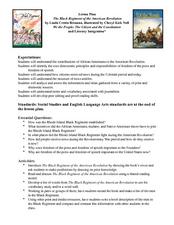Curated OER
Heart Mobiles In Action
Students design a mobile or wall hanging that reviews the circulatory system. In this circulatory system lesson, students work in small groups to identify the structures of the heart, and create a model in the form of a two or three...
Curated OER
Medieval Castles
Second graders design a scale model of a medieval castle and its surroundings including the following items: castle, moat, bailey, drawbridge, turrets, dungeon, grounds, and outer walls. A perfect lesson for those kids who are fascinated...
Curated OER
Where the Red Fern Grows: A 4th Grade Literary Focus Unit
Fourth graders explore the human and animal connection along with the idea that death is a part of the life cycle. They read "Where the Red Fern Grows." Students examine the feelings and emotions surrounding death and they discover the...
Curated OER
All and Every Exercise
In this all and every worksheet, students fill in the blanks to sentences with either the word all or every. Students fill in the blanks to 19 sentences and write 4 on their own.
Curated OER
Dilations- What a Stretch!
High schoolers perform dilation on various geometric shapes. They also discuss pros and cons of dilation and employ the Frayer Model to study the vocabulary words in this section.
Curated OER
P.E. Bees
Students practice positive social skills and manners in this short lesson that is used to start each session of P.E. class. They identify a positive behavior, such as be on time, written on a bee cutout pasted among others on the gym...
Curated OER
Ask the Oracle
Students invent an imaginary character that has the ability to time travel to China and create stories in the tradition of a traveler's tale, whereas their characters visit China's capital city, Beijing, and go to the Great Wall of China...
Curated OER
Naming Trust
Students write a poem. In this character lesson, students read a quote about trust and friendship and discuss what they mean. Students write an acrostic poem using the letters in their name and come up with a phrase or word that...
Curated OER
Describing Feelings
In this lesson learners explore simple feelings. Students interview their peers and question them as to whether a particular situation is frightening to them or not. Learners further describe words as scary using a yes or no checklist.
Curated OER
Teaching Tip -Vocabulary procedure
Participants are introduced to a variety of procedures to teach vocabulary. They gain oral practice with creative adjectives. They offer various vocabulary presentations along with games and acting out the words.
Curated OER
My Family
Students examine the different kinds of families. In this family lesson plan, students discuss who is in their family, talk about how families should treat each other and how they feel about their family. Students make posters that show...
Curated OER
Exploring Gear Trains
Students work together to build a simple gear train. They record their observations as it gains speed and how the gears rotate. They develop rules about gears based on these observations.
Curated OER
Independent - To Be or Not Top Be - Day 3, Lesson F: Coming to Terms
Fifth graders develop vocabulary through the study of the American Revolution.
Curated OER
Summertime
Explore expressive reading through the read-aloud Summertime: From Porgy and Bess. Readers will make predictions about the text and listen to the song Summertime. They will also identify how the story relates to the song lyrics.
Curated OER
The Common Core Literacy Standards - Kindergarten Posters
Can we do it? Yes we can! Your class can become Common Core masters with a fine set of posters that state each of the kindergarten literacy standards in a friendly "we can" statement. Each of the posters contains two standards, a "we...
Curated OER
Spring into Poetry
How many different types of poetry are there? Let me count them; list poems, haiku, and makes-me-think poems are only a few. Learners create their own poems accompanied by artistic projects such as haiku poems written on kites.
The New York Times
Revolt! Comparing Historical Revolutions
What elements are needed to have a revolution? How do historical revolutions from across the globe and generations compare with one another? This is an excellent activity that incorporates group work, source analysis, and an engaging...
Curated OER
The Common Core Literacy Standards - Grade 3 Posters
Brighten your third grade classroom with this series of colorful Common Core displays. Including all of the English Language Arts standards and substandards, each with supporting illustrations and examples, this resource provides clear...
Curated OER
The Common Core Literacy Standards - Grade 2 Posters
Support second graders with mastering the Common Core using this series of classroom displays. With each English language arts standard rewritten as a We can statement and accompanied by images and examples, this resource provides...
Curated OER
The Common Core Literacy Standards - Grade 1 Posters
Prepare your first grade classroom for the Common Core with this series of colorful literacy standard displays. Providing children with clear learning objectives throughout the school year, this resource includes each English language...
Mathematics Vision Project
Circles: A Geometric Perspective
Circles are the foundation of many geometric concepts and extensions - a point that is thoroughly driven home in this extensive unit. Fundamental properties of circles are investigated (including sector area, angle measure, and...
It's About Time
Run and Jump
Has your class wondered how fast a human could run or how high they are capable of jumping? Help them understand these concepts as they explore acceleration and use an accelerometer to make semiquantitative measurements of acceleration...
Roald Dahl
The Twits - Dirty Beards
The problem with beards is that they collect a lot of food. The first lesson in an 11-part unit related to The Twits by Roald Dahl explores the hairy jungle that is Mr. Twit's beard. A concluding project has learners create their own...
Curated OER
We the People: The Citizen and the Constitution: The American Revolution
The contributions of African-Americans to the American Revolution are the focus of this Social Studies and language arts lesson. After reading and discussing Linda Crotta Brennan’s The Black Regiment of the American Revolution, class...



